|
Welcome to Future Green Homestay
March 12, 2006 Thailand Arrival
So after a 4 hr. ride we arrived at Future Green, the Homestay place owned by Jacques Delacretaz, his Thai wife La-Or, and his two sons Itsara (9) and Kim (4). Man, it’s hot here,
about 90 degrees when we arrive. Jacques is an agricultural engineer (agronomist) and oversees their
fruit garden as well as being the tour guide for us. La-Or is the cook and she is amazing. Not only
did our food taste great, but the presentation amazing. Future Green is a wonderful place that’s
tucked away in a tiny village 4km from Pong Nam Ron. We unpacked our stuff in two bungalows—me and
Dominique in one, and Nicky and Annette in the other. They are tiny, but very cute and very usable
places, both with air conditioning. Here's a picture of our cabana, my first attempt to stitch
together two pictures. Yes, it looks like I need some practice in this area.
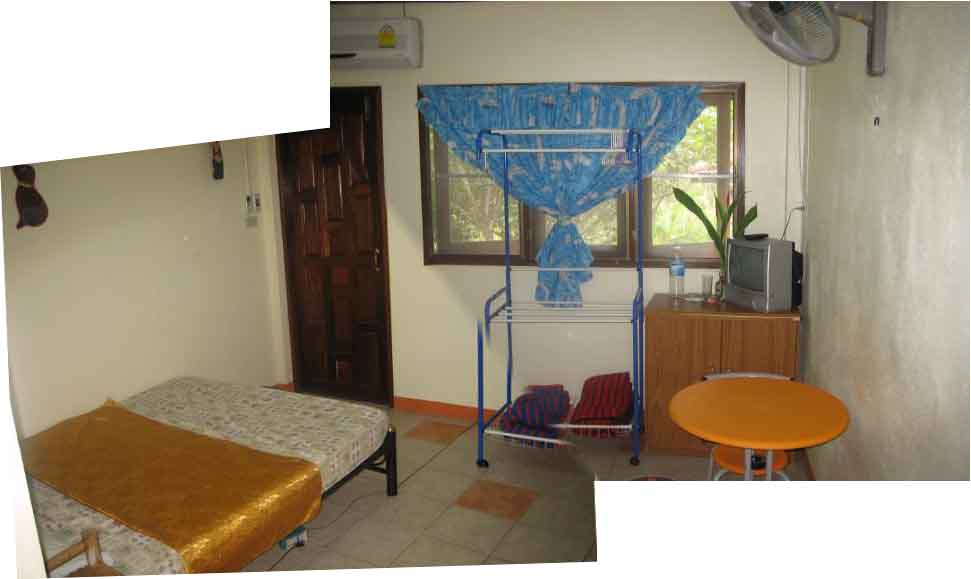
Man, it’s hot here.
Another family is also staying at Future Green and they’re also taking extended time off to
travel. But these guys are hard core. They put us to shame. They are taking 2 years a with their
13 yr. old daughter, a 6 yr. old boy and an 11 month old boy (he was 5 months old when they
started). They spent 7 months in Madagascar often without electricity or a place to stay prior
to coming to Thailand. They would got to a small village and ask around if anyone would host
them at their house for a while. They really got to know the people and the culture. They’re
also planning on spending a couple days at another bungalow here that’s very primitive—two
rooms, electricity, outdoor plumbing. Period. No kitchen, no refrigerator, no AC. And the
building is about a mile away from the main road. Yeah, these guys are hard core, and they’re
a wonderful family. I really enjoyed talking with them and learning about their trips. Check them out: Lafamily.
Our dinner that night was rice with several side dishes—stir-fried veggies with pork, an
omelet with pork/tomato stuffing, and a coconut-based cream soup with fish, squid and veggies.
Plus sticky rice. Sticky rice is a high-gluten based rice that’s served in a wicker container.
You use your hands to get a bunch of it to put on your plate. Tastes the same as regular white
rice, but really neat sticky texture.
Rice is the staple here. They have rice with everything—cereal, rice, air, etc. Buy some gas?
Get some rice!
Neither Nicky nor I slept well that night. Still fighting the 12 hr. time zone difference
(13 hrs. difference in HK, 12 hrs. difference in Thailand). But the beds were comfy and the
accommodations wonderful. The bathroom took a page from RV bathrooms in that the entire room
is the shower. There’s a drain in the corner of the room that all the shower water runs. It’s
instant hot water, and very usable. The toilet is very authentic Thai—no running water. There’s
a water holder next to the toilet with a bowl that you use to flush your waste down the toilet.
And a water hose to clean you. The cheap man’s bidet, eh? But I found it to be very usable with
no complaints, and the kids had a good time manually flushing their poops down the toilet. It
kind of reminded me of the scene in the movie “Madagascar” where the lion who has been I a zoo
his entire life is surprised to find out that he’s in the wild:
Alex the Lion: “The WILD?! Like wipe yourself with a leaf wild!?”
Chief of the Lemurs: “Wipe? Who wipes?”
March 13, 2006
Dominique and I woke up the next day around 5am. She and I decide to go exploring that morning
so we grabbed our flashlights and head on down the road. We see several of our neighbors living in
pretty much nothing but shacks. Everyone has electricity, but some of the plumbing is outdoors.
Many of the smaller/older homes are made of wood only, and you can see through many of the cracks
in the seams. There are wild roosters/chickens/dogs running around, and at 6am the mayor of the
village gets on the loudspeaker to alert the villagers about the days news and upcoming events.
This announcement happens everyday at around 6am and 6pm. There are loudspeakers attached to the
power poles that allow this kind of communication. Very loud, but also effective for a small
village like this. The message is simple: drive carefully; the next town meeting is XXX; another
person died yesterday from XXX. Drive carefully. What a bunch of crazy drivers here. I saw 3
adults on a small motorbike and they had an infant sandwiched between them. Everyone weaves
in/out of traffic with wild dogs running in the roads. I think there’s a law that you have to
get about 2” away from the car in front of you before you swerve to pass it. Crazy man.
Jacques took us to a farm that makes rubber. Who knew there were farms that make rubber? I always
thought there was just one farm that made rubber and that farm was called DuPont. This particular
farm is small and has only 800 rubber trees. Each morning at 2am, two workers go to every tree and
make a tiny incision or score that’s about ¼” deep and about 16” long, at a 45 degree angle. At the
bottom of this incision they hang a small bowl that collects the rubber sap. This collection process
takes about 4-5 hrs. The average sap collection each night is anywhere from 12-24 gallons. Once they
have the raw sap, they mix it with water and a little bit of acid in order to speed the congealing
process. They do this by hand in large baking pans, using a small spatula to stir the mixture. It
hardens quickly and once it gets to a soft playdough like consistency, they’ll take it out of the
pans and use a big roller to flatten the rubber to about ¾” thick. Some people will just walk on
it and use their feet to flatten it. Then they take this big pancake piece of raw rubber and put
it through a mechanical roller several times, each time making the rollers a little closer together.
This does two things:
- flattens the rubber to a better working thickness
- gets rid of a lot of excess water in the rubber.
Once they get about a 1/8” thickness, they’ll put it through another roller that makes it a little
thinner, and perforates it to get more water out of it. Then they air dry it in the sun for two days,
then air dry it in the shade for another week. Each piece of rubber (about 30” x 16”) will get about
100 baht at the market (about $2.50US). The two workers get half of the sales price and the owner of
the land gets the other half. Today we saw these two workers finish 12 pieces of this rubber for a
total sales price of 1200 baht. Of this they each get 300 baht for the day and the owner gets the
remaining 600 baht. The average worker in Thailand gets about 150 baht per day, so this is a
pretty good gig. Their workday starts at 2am and they finish around noon. They work 5 days and
get one day off, then start another 5 day gig. Here they are using a rolling machine to make the
rubber mats.
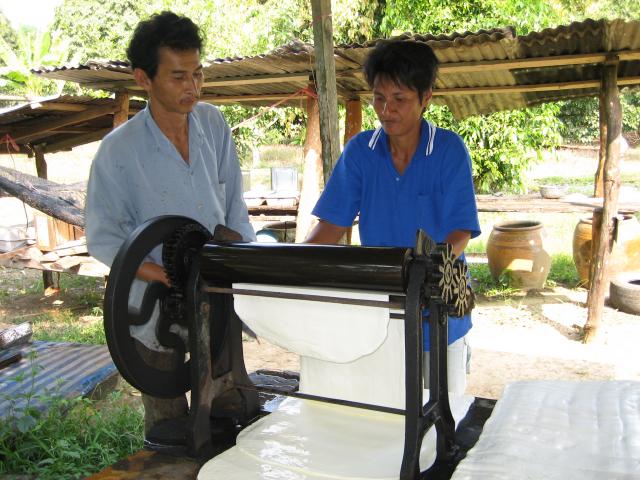
Man it’s hot here.
We went to the market today because Monday is the big market day. Everyday the market is open,
but Monday is the big gathering day. The market is what you’d think that an outdoor market is just
from watching any movie that has a foreign market scene. Lots of cart vendors, some permanent,
some mobile, selling food, drinks, house wares, clothes, beauty stuff, music, mobile phones,
electronics, just about anything except furniture. In this particular market the people are
very courteous and friendly, so I found it to be a pleasant experience
About half of the market is dedicated to food. Now Thai food at the market is an adventure in
itself. We saw the normal stir fry carts and drink carts, but the interesting places were the meat
sellers. In the US we don’t have as close of a relationship with our meat. We like it pre-packaged,
behind glass, and in ice or at least in a refrigerated section. Here the meat is in the open, no
refrigeration, and all the people and the insects can enjoy the look and smell of it. I found it
difficult to get my head around this. But the veggies and fruits were very fresh and tasty.
The smells of the market are amazing. A plethora of odors attacks your olfactory senses. There’s
wonderful cooking foods, fruit smells, perfumes, raw sewage (yes, you read correctly), gag-a-maggot
cooking smells (some of the food there just looked inedible. I’m amazed at what some people eat.
There were whole pigs’ heads there). The color, the movement, the smells all made the market such
a unique place.
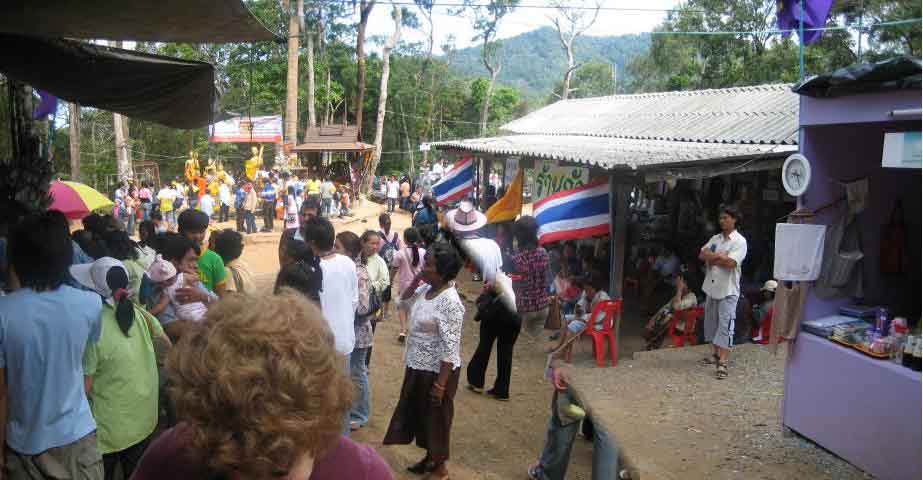
The most interesting thing for me at the market was seeing the Thai people’s reaction to seeing
Dominique and Annette. Many have never seen blond curly hair before, or kids with such fair skin.
Jacques was a tour guide at the market and he continually translated things that people said about
the girls:
“They look like Barbie dolls.”
“Look at that beautiful white skin” (apparently Thai people use beauty products to lighten
their skin. We Americans are always trying to darken our skin by tanning. Strange world we live in, eh?)
“Forget about the little girls, look at that hunky American man. Grrrrr!” (Hey, I’m just
telling you what Jacques translated for us).
More than one woman came up to both the girls and wanted to touch them. Several came up to
Dominique and hugged her; Annette was very shy and was not inviting hugs or touches. And people
kept staring as we walked by. Everyone. I thought this type of reaction might happen because
I’ve heard about it before, but I was a little surprised because they receive US television.
I thought that the TV or movie exposure would lessen these reactions (and maybe they did),
but I guess it’s one thing to see something in a movie and another to see it in person.
Authentic Thai dinners are very interesting and have flavors that you wouldn’t believe
could work together. Some, in my opinion, don’t work together, but I’m a pretty fussy eater.
Tonight’s dinner was fish-based, around a staple of rice (thank goodness for the rice). We
had really good stir fried veggies with pork, a fish cake made with veggies and coconut, and
whole fish grilled in some sort of tree leaves. Very cool way of cooking the fish. They serve
all the food “family style,” and people help themselves to each of the dishes. Traditional
Thai people eat only with a fork and spoon. The fork is used to push the food onto the spoon.
No knives included, nor napkins. In fact, the first time I saw napkins was at lunch in the
market and I swear the napkin was the size of a credit card and was single ply. I guess the
Thai people are less-messy eaters than we Americans….
March 14, 2006
Nicky’s birthday! 38 years old today. And I forgot it completely. I have no sense of time
or date here, but I do know where I’m heading thanks to my new Timex Expedition CR1620 water
resistant watch with digital compass and Indiglo lighting. Isn’t that enough of a present
for my wife on her 38th birthday? To always know in what direction we’re headed? “Begin
with the end in mind.” –Stephen Covey. Hey, I know where we’re going baby…
Dominique and Darren making baskets with a neighbor.
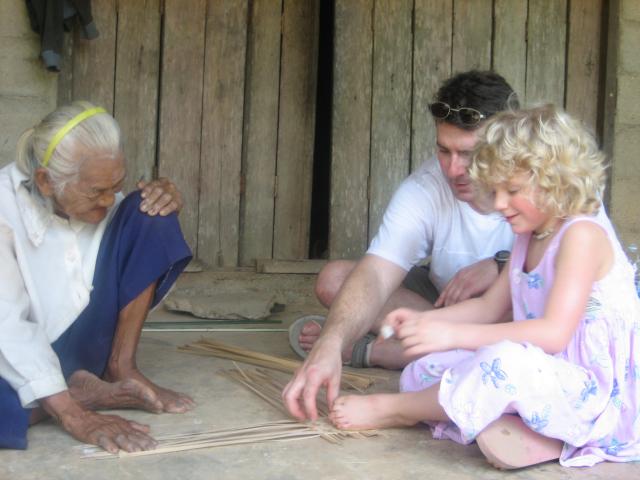
So after a quick breakfast and some games with all the kids, we’re off this morning to visit
some waterfalls (I’m not exactly sure where they are…). On the way we stop at a small place
that makes water tanks. These tanks are used as cisterns in this area of Thailand and Cambodia.
A cistern is a container that receives and holds rainwater to use later on as drinking or
washing water. It’s very clean and natural water. At the place that we’re staying they have
about a dozen of these, and we get all our water from these pots because it’s the only source
of water during the dry season (Jan – April).
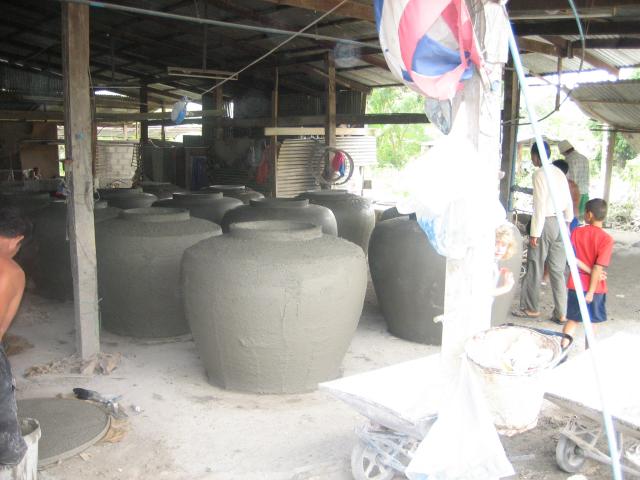
The construction of these pots is fascinating. It starts with a circular base that sits on a
big piece of paper. The base is about 3 feet in diameter and about 2” thick of concrete. Once
that dries, they use a series of concrete blocks to build the form/shape of the pot, using small
pieces of wood as spacers. Once all these blocks are put in place and form the shape of the pot,
they use a trowel to put concrete on the outside of the blocks. This is the pot. Once the concrete
dries, they’ll put a top on the pot, then a watery concrete mixture called a “slurry” to smooth
the outside of the pot, then someone will jump inside the pot and take out all the blocks and
wooden spacers. Once that’s finished they’ll take that same slurry to smooth out the inside of
the pot. The workers start early in the morning around 3am. and finish around noon. They can
make about 8-12 pots a day. The finished pot is about 5 feet tall and 5 feet in diameter at the
largest part. It only costs 800 baht, which is about $20. Amazing. I thought I’d get one of
these for Nicky’s birthday but they don’t easily fit in the overhead luggage compartment on airplanes.
Water Barrels Video
Note: if you can not see the video, download QuickTime and view the movie with it.

Here we are at the waterfalls, Jacques and Annette making like the Buddha.
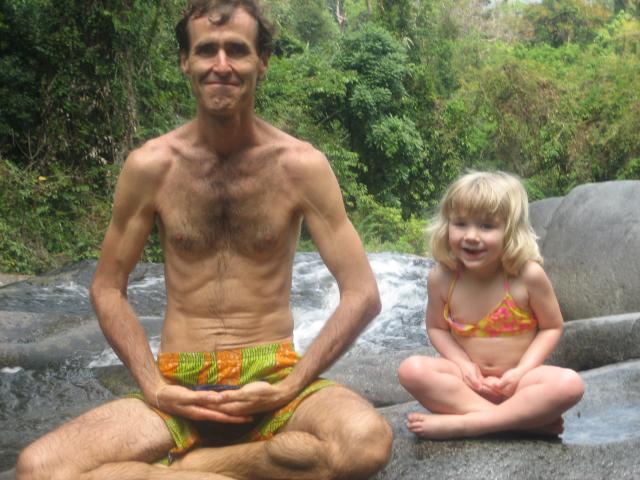
The Holy Rock
The next morning Jacques plans to take us to a very holy site that’s only open Jan – March every
year. It’s a national park that hosts the Buddha’s footprint up on the mountain. Because of the mass
of people wanting to visit, they only allow small trucks outfitted with benches in the back to go
up/down the mountain. Remember what I told you about Thai drivers? If you’ve ever seen the Baja
buggy races, then you have an idea of the ride up the mountain in the back of one of these jeeps.
I was fairly bruised by the time we made it to the top and thought that we should open a small
Urgent Care facility there. We’d have a captive audience with plenty of medical issues…
Here's a good picture of us riding in the back of the truck going up the mountain, average speed
of about 75 mph. Those are not smiles on our faces; they are grimaces of strained muscles and pain
from trying to hold on and ignore the sharp jabs from the poles in our backs.
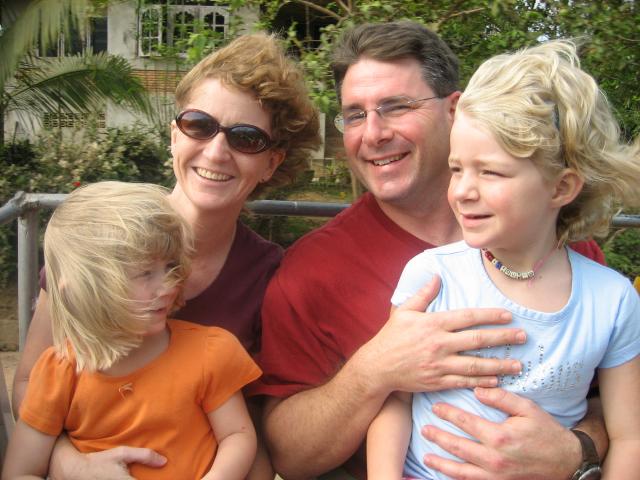
Now that we’re at the top, Jacques tells us that we have a nice 30 min walk to see the holy rock
and Buddha’s footprint. This guy comes from a different part of the world than we do. The 30 min
walk immediately turned into a 45 min hike/climb. They should sell oxygen bottles here. It was
more strenuous than we thought, especially since both kids complained and wanted to be carried.
Nicky actually ended up carrying Annette most of the way up.
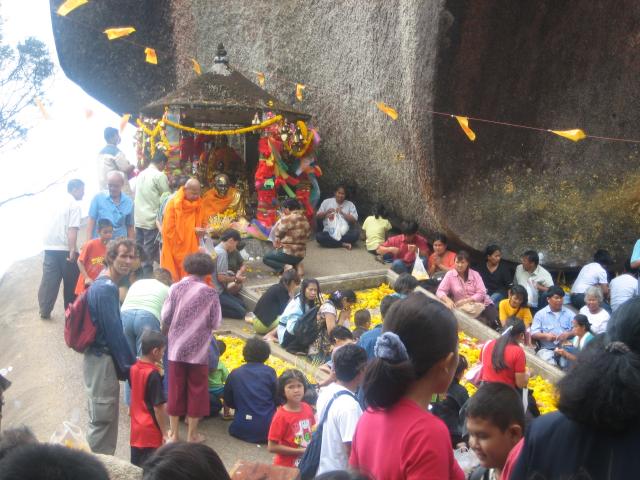
The view at the top is amazing, and the strong breeze feels really good on my sweat-soaked body.
It’s interesting to see that people of all ages pay respect at this holy place. It’s also interesting
to see how the vendors (yes, there are food/souvenir vendors at the top of the mountain) get their
supplies. Pack humans with 40lbs. boxes loaded on their shoulders.
One way they pay their respects is by tossing yellow flowers and incense sticks along the trail.
So there are vendors that sell these items all along the trail, and the entire mountain is covered
with sticks of incense and yellow flowers. There are dozens of people whose only duty is to pickup
this stuff for trash.
March 15, 2006
Lessons Learned:
- Always carry an extra battery and extra bland video tape when going on tours. During the
elephant show we ran out of battery on the digital camera AND ran out of tape on the camcorder. Yikes.
- Never let your kids go on a hike with new shoes or sandals because they’ll get blisters
and whine/complain the entire time. Rookie parent mistake here. This might be why we ended up
carrying both girls during our waterfall trek.
- Always carry a first aid kit. This, we’ve done, and for which we’re very thankful. The band
aids and the antibiotic cream have both been well used so far. Boo boos are still painful even in Asia.
- Pepto Bismol is our friend.
- Khob Khun Krab is Thai for “thank you” if you’re a male; if you’re female then it’s Khob Khun Kha.
|